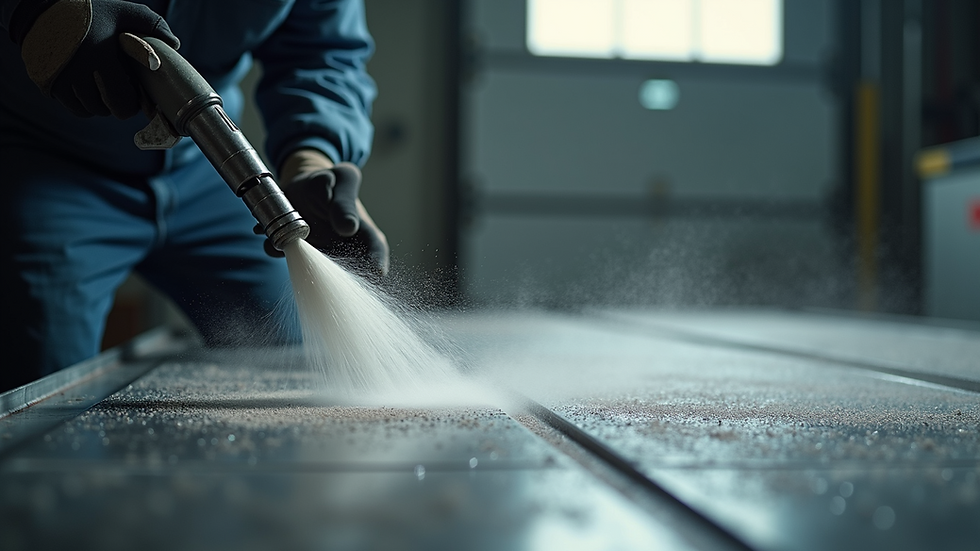Understanding Professional Sand Blasting Services
- Mound House Powder Coating

- 3 days ago
- 4 min read
When it comes to preparing metal surfaces for finishing, protection, or restoration, sand blasting stands out as a powerful and efficient method. Over the years, I have seen how this technique transforms dull, corroded, or painted surfaces into clean, smooth canvases ready for the next step. Whether you are dealing with industrial equipment, automotive parts, or architectural metalwork, understanding the ins and outs of sand blasting can save you time, money, and frustration.
Sand blasting is not just about blasting sand at a surface. It is a precise, controlled process that requires expertise, the right equipment, and knowledge of materials. In this post, I will walk you through the essentials of sand blasting, explain how costs are calculated, and share practical tips to help you make informed decisions for your projects.
What Is Sand Blasting? A Sand Blasting Overview
Sand blasting, also known as abrasive blasting, is a surface treatment process where fine particles are propelled at high speed against a surface. The goal is to clean, smooth, or etch the surface by removing rust, paint, dirt, or other contaminants. The abrasive material can vary widely - from natural sand to glass beads, steel grit, or even organic materials like walnut shells.
The process works by using compressed air or water to shoot the abrasive particles. The impact strips away unwanted layers and prepares the surface for coatings, painting, or further treatment. This method is highly effective for metal surfaces but can also be used on concrete, wood, and glass.
Key Benefits of Sand Blasting
Thorough cleaning: Removes rust, old paint, and corrosion completely.
Surface preparation: Creates a rough texture that improves coating adhesion.
Restoration: Revives old or damaged metal parts to near-original condition.
Customization: Different abrasives and pressures allow for tailored finishes.

Types of Abrasives and Their Uses
Choosing the right abrasive is crucial for achieving the desired finish without damaging the material. Here are some common abrasives and their typical applications:
Silica Sand - Traditional abrasive, effective but less used due to health concerns.
Glass Beads - Provide a smooth, polished finish; ideal for delicate surfaces.
Steel Grit - Aggressive abrasive for heavy-duty cleaning and surface profiling.
Aluminum Oxide - Durable and reusable; great for removing tough coatings.
Walnut Shells - Gentle abrasive for cleaning without damaging softer materials.
Each abrasive type has its own grit size, hardness, and impact level. For example, steel grit is perfect for industrial metal parts needing deep cleaning, while glass beads are better for automotive parts requiring a smooth finish.
How to Calculate Sand Blasting Cost?
Understanding the cost structure of sand blasting helps you budget effectively and avoid surprises. Several factors influence the price:
Surface area size: Larger surfaces require more time and abrasive material.
Type of abrasive: Some materials are more expensive or reusable, affecting cost.
Surface condition: Heavily corroded or painted surfaces take longer to clean.
Accessibility: Hard-to-reach areas may require special equipment or extra labor.
Project complexity: Intricate shapes or delicate materials need careful handling.
Typically, sand blasting is priced per square foot or hour. For example, a simple cleaning of a 100-square-foot metal panel might cost less than $2 per square foot, while specialized blasting with premium abrasives could be higher.
To get an accurate estimate, I recommend consulting with a professional provider who can assess your specific needs. They will consider all variables and provide a detailed quote.
Practical Tips for Choosing a Sand Blasting Provider
Selecting the right sand blasting service is critical to the success of your project. Here are some tips to guide your choice:
Experience matters: Look for companies with a proven track record and expertise in your industry.
Equipment quality: Modern, well-maintained equipment ensures consistent results.
Safety standards: Sand blasting involves dust and debris; proper containment and protective measures are essential.
Customization options: A good provider offers various abrasives and techniques tailored to your project.
Customer reviews: Check testimonials and case studies to gauge reliability and quality.
For example, Mound House Powder Coating has over 30 years of experience delivering expert metal finishing services across Northern Nevada. Their specialized offerings, including CERAKOTE coatings, complement their sand blasting expertise to ensure durable and aesthetically pleasing results.

Maintenance and Aftercare Following Sand Blasting
Once your surface has been sand blasted, proper aftercare is essential to maintain its condition and maximize the lifespan of coatings or finishes applied afterward. Here are some recommendations:
Immediate coating: Apply paint, powder coating, or protective sealants soon after blasting to prevent oxidation.
Regular inspections: Check for signs of rust or wear, especially in outdoor or harsh environments.
Cleaning: Use gentle cleaning methods to avoid damaging the blasted surface.
Storage: Store metal parts in dry, controlled environments to reduce corrosion risk.
By following these steps, you ensure that the investment in sand blasting pays off with long-lasting, high-quality finishes.
Elevate Your Metal Finishing Projects with Expert Sand Blasting
Sand blasting is a versatile and powerful technique that can dramatically improve the quality and durability of metal surfaces. Whether you are restoring industrial equipment, preparing automotive parts, or enhancing architectural elements, understanding the process and working with skilled professionals makes all the difference.
If you want to achieve superior results, consider partnering with a trusted provider who offers comprehensive services, including advanced coatings like CERAKOTE. This combination guarantees that every project is masterfully crafted for both durability and aesthetic appeal.
Explore your options and take the first step toward flawless metal finishing today.




Comments